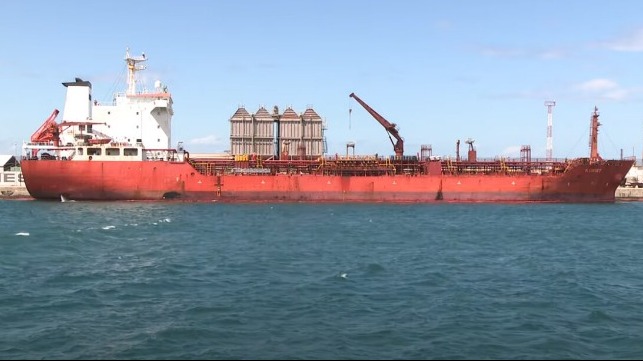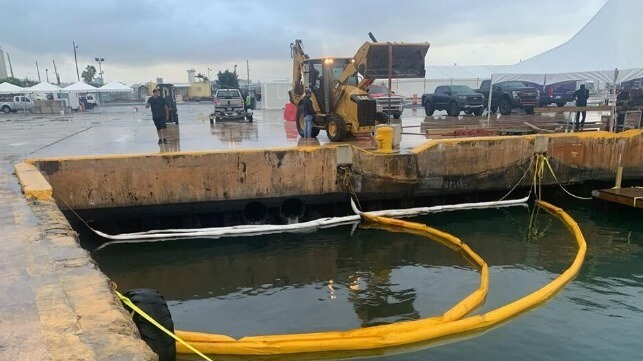ECOCIDE
Crack in Tanker’s Hull Causes Largest Oil Spill in Ceuta Port History

Spanish authorities at the port of Ceuta on the southern side of the Strait of Gibraltar declared contained what they believe was the largest oil spill in the port’s history. The spill came from a crack in the hull of a Turkish-owned product tanker that is now being detained and facing stiff fines.
The port captain for Ceuta, one of only two Spanish ports in Africa and a vital link in Mediterranean traffic, told reporters they received a report of an oil leak from the product tanker K Onset (12,900 dwt) on Tuesday evening, April 30, and they immediately mobilized a containment effort. Within about two hours he said the leak had been contained. They deployed two containment booms and one absorbent boom.
The Liberia-flagged tanker managed by Chemfleet of Turkey arrived on April 30 from the Spanish port of Vilagarcia and was conducting a fueling operation. The latest estimate is that the vessel leaked between 25,000 and 30,000 liters of a light marine fuel from a crack that measured 32 centimeters (approximately 12.5 inches) in one of the fuel tanks. Westerly winds helped to contain the spill and throughout the day on Wednesday, teams could be seen with absorbents mopping up the fuel. The port captain believes at least 85 percent of the spill was recovered.
The K Onset is now being detained at the port and it has been ordered to pump all the fuel from the cracked tank. The port captain said the tank would be vented and then examined and that they would require repairs before the vessel departs.
In addition, the port is demanding a deposit of €72,000 ($77,000) consisting of €60,000 in fines and €12,000 toward the clean-up costs. The final fine is yet to be determined but media reports said it will be at least €200,000 to €250,000, ($214,000-$267,000) with one report saying it could reach a half million euros.
The vessel was cited in December 2023 for 18 deficiencies during a Port State inspection in the UK. Among the items identified were hull corrosion as well as issues with propulsion and other structural condition issues. However, the vessel was not detained.
Port officials in Ceuta acknowledged that this was the third incident this year although noting the prior two events were much smaller. Media reports said in mid-February, a Panama-flagged Ro-Ro cargo vessel, Lider Trabzon (7,225 dwt) had to pay €136,000 ($145,000) after another oil spill. Last week, a general cargo ship registered in Gibraltar, Schillplate (3,175 dwt) also caused a small spill in the port.
Mystery Spill Returns to San Juan Harbor

The U.S. Coast Guard is working to clean up a mystery spill at the port of San Juan, Puerto Rico. According to Sector San Juan, a recurring discharge of heavy oil is seeping out of the storm drain system into the water, and experts are trying to trace it back to its source. In the meantime, thanks to funding from the Oil Spill Liability Trust Fund, a contractor is keeping the contamination contained and pulling oil out of the water. So far, about 1,770 gallons of waste have been recovered, including 17 drums of absorbent materials.
"The discharged oil is being contained and recovered," said Lt. Cmdr. Ray Lopez, Sector San Juan Incident Management Division Chief. "We suspect this spill may be tied to an unidentified inactive historical source that for years has resulted in a series of mystery spills along the Old San Juan waterfront."
It is not the first time that an oil seep like this has leaked into San Juan's harbor. Three years ago, another release of a substance that looked like Bunker C occurred at Pier 4 (the San Juan cruise terminal). Recurring contamination was found in a storm drain system, as well as in the harbor, and response crews used vacuum trucks and absorbent boom for three weeks to clean it up. The responders suspected that the source might be somewhere in a network of buried oil pipelines that dated back to the early 1900s.

Manhole contaminated with heavy oil from the 2021 spill (USCG)
The response crews are now planning an underground survey to find and assess the condition of long-abandoned oil pipelines that were buried in the area in the early or mid-1900s. The lines are no longer in service, but they may well have some residual oil inside.
Samples of the 2021 and 2024 leaks have some similarities, according to the Coast Guard, and might come from one common source of petroleum leaking into the storm drain system. Like last time, the response team plans to do a subsurface site assessment to determine the extent of any soil contamination and determine the source of the spill.
No comments:
Post a Comment